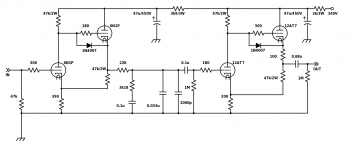The best way for me to use phono tubes is like the Riaa comes from Klimo.
I use this in a circuit, too. I use a 6N1P for the first gain and CF, and a 12AT7 for the second gain and CF in constant current draw.
... one shouldn't assume that "rp" is constant for all triodes, it changes over time and varies from tube to tube.
Then I suppose somebody could estimate rp_max, rp_typical, and rp_min over the working lifetime of a tube (or perhaps of a population of tubes). They could calculate their RIAA deemphasis circuit's component values three times: once with rp_max, a second time with rp_typical, and a third time with rp_min. Then for each component, select its value to be the arithmetic average (possibly geometric average) of the values calculated for the three rp's.
It seems to me this approach works just as well, whether component values are calculated by closed form expressions, or iterative optimization algorithms.
if Rp is low,as it is in SY's phono (HMN) pre with D3a (2k2), the issue is minimized. then the trade-off is noise.It seems to me this approach works just as well, whether component values are calculated by closed form expressions, or iterative optimization algorithms.
to kodabmx
In my opinion this circuit is the best for the riaa for different reasons.
The fisrt is that you can bypas or not the cathode of gain stage without any changes on riaa eq because the input Z of c.f. is very high and the Zout still low.
In this wai, with ECC83 you have about 42 dB of total gain without any bypass till 46-47 with all bypass and this helps.
In every case to get a right results you must have a anti-riaa circuit and a minmum of instruments to check the response or a very god ac millivoltmenter where, following the table of riaa curve (in db) , you can test the voltages
Walter
In my opinion this circuit is the best for the riaa for different reasons.
The fisrt is that you can bypas or not the cathode of gain stage without any changes on riaa eq because the input Z of c.f. is very high and the Zout still low.
In this wai, with ECC83 you have about 42 dB of total gain without any bypass till 46-47 with all bypass and this helps.
In every case to get a right results you must have a anti-riaa circuit and a minmum of instruments to check the response or a very god ac millivoltmenter where, following the table of riaa curve (in db) , you can test the voltages
Walter
to kodabmx
In my opinion this circuit is the best for the riaa for different reasons.
The fisrt is that you can bypas or not the cathode of gain stage without any changes on riaa eq because the input Z of c.f. is very high and the Zout still low.
In this wai, with ECC83 you have about 42 dB of total gain without any bypass till 46-47 with all bypass and this helps.
In every case to get a right results you must have a anti-riaa circuit and a minmum of instruments to check the response or a very god ac millivoltmenter where, following the table of riaa curve (in db) , you can test the voltages
Walter
Agreed. And even if you use a 12AX7 as the first tube it's Zout is still only 1k5. Using a 6N1P this drops to 430R
I actually use a slight positive FB in the one I'm using. Got the idea from John Broskie... I really like the sound!
Cheers
Attachments
- Status
- Not open for further replies.
